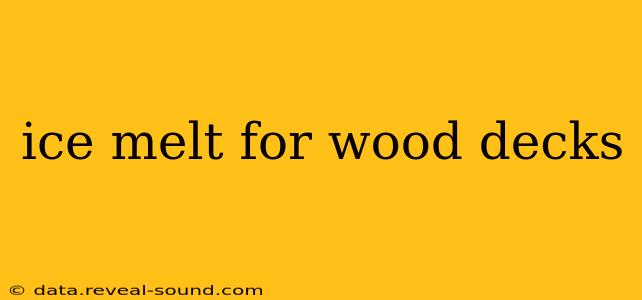Winter's icy grip can pose a serious threat to your beautiful wood deck. While shoveling snow is essential, simply removing snow isn't enough to prevent ice buildup. Choosing the right ice melt is crucial to prevent damage to your deck's wood and finish. This guide explores safe and effective de-icing solutions for wood decks, addressing common concerns and helping you protect your investment.
What are the safest ice melts for wood decks?
This is the most crucial question, and the answer depends largely on the type of wood and finish your deck possesses. Generally, avoid using rock salt (sodium chloride). While highly effective at melting ice, rock salt is extremely harsh and can severely damage wood, causing discoloration, cracking, and even rotting over time. It's also damaging to surrounding plants and vegetation.
Safer alternatives include:
- Potassium chloride (KCl): This is a generally safer option than rock salt, being less corrosive to wood. However, it is still advisable to use sparingly and rinse thoroughly afterwards. It's also less effective in extremely cold temperatures.
- Calcium magnesium acetate (CMA): This is considered a more environmentally friendly option and is gentler on wood than rock salt or potassium chloride. It's also less corrosive to metals.
- Pet-safe ice melt: Many pet-safe ice melts utilize CMA or other less corrosive chemicals. If you have pets, this is an excellent choice.
What happens if you use rock salt on a wood deck?
Using rock salt on a wood deck is a recipe for disaster. The salt draws moisture from the wood, leading to:
- Discoloration: Salt can leave unsightly white stains or blotches on your deck's surface.
- Cracking and splitting: The moisture loss can cause the wood to become brittle and crack, especially in already stressed areas.
- Rot and decay: Salt creates a highly corrosive environment, accelerating the process of wood rot and decay.
- Damage to the finish: Salt can strip the stain or sealant from your deck, leaving it vulnerable to the elements.
Are there any ice melts that won't damage my deck?
While no ice melt is completely without the potential for damage, calcium magnesium acetate (CMA) is generally considered the safest option for wood decks. Its gentle nature minimizes the risk of harming the wood or its finish. Remember to use sparingly and rinse thoroughly after the ice has melted.
How can I prevent ice buildup on my wood deck in the first place?
Prevention is always better than cure. Here are some proactive steps you can take to minimize ice buildup:
- Regular snow removal: Remove snow as soon as possible after a snowfall to prevent it from compacting and forming ice.
- Proper drainage: Ensure your deck has adequate drainage to prevent water from pooling and freezing.
- Deck orientation: Consider the sun's exposure. A south-facing deck tends to receive more sunlight and is therefore less prone to ice buildup.
What should I do after using ice melt on my wood deck?
After using any ice melt, it is crucial to:
- Rinse thoroughly: Use a garden hose to rinse away all traces of the de-icer. This helps prevent any lingering salt or chemical residue from damaging your deck.
- Inspect for damage: Check your deck for any signs of damage such as discoloration, cracking, or warping.
- Re-seal if necessary: If your deck's finish has been compromised, re-sealing is recommended.
By understanding the potential risks associated with different ice melts and following preventative measures, you can keep your wood deck safe and beautiful throughout the winter months. Remember, always prioritize the safety of your deck and choose the least harmful de-icer available.
